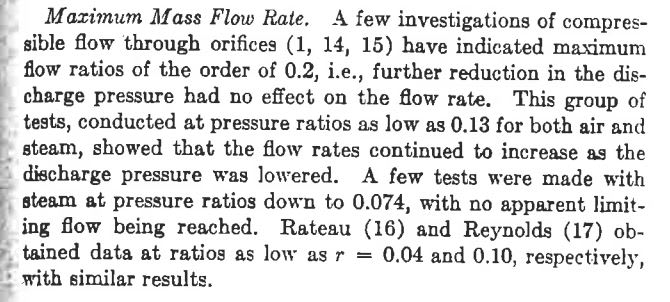Latexman, the part of the Cunningham´s article you attach is clear in the conclusion, but it´s necessary to analyze in deep all the document to see the limits of the tests, before extend the results to whichever pressure, pipe and RO size.
The article has as Reference 1 the paper of T. Stanton which states that the tested RO plate with a hole diameter of 6.15 mm, choke at P2/P1 = 0.2
Cunningham tested with air at P1 = 113 psia a RO plate of do/D = 0.15 installed in a 2 in pipe and the minimum measured value of P2/P1 was 0.13. Also tested with steam a similar plate, installed in a 3 in pipe and the results were the same.
Additionally tested with air at P1 = 90 psia, 7 RO plates with values of do/D from 0.2 to 0.8, installed in a tubing of only D = 0.53 in.The minimum tested value of P2/P1 was 0.14. The Figures 2, 3 and 7 of the article show the expansion factors Y obtained in the tests, that are extrapolated from P2/P1 = 0.13 to 0, assuming that the RO don´t choke.
In my opinion, considering only this article, seems risky to assume that the RO 1 hole thin plates, installed in pipes of more than 3 in and for pressures greater than 100 psia, don´t choke.
I think it would be necessary more tests with higher pressures and greater pipe sizes to know if the RO thin plates choke or not.
In the design of the nuclear power plants, there are RO plates to limit the steam discharged in the case of a pipe break and usually the calculations assume they choke.


